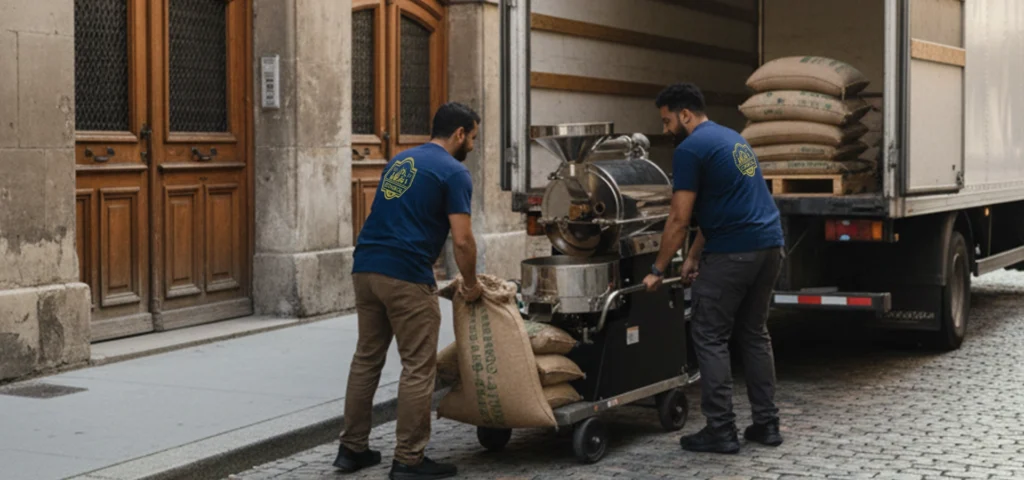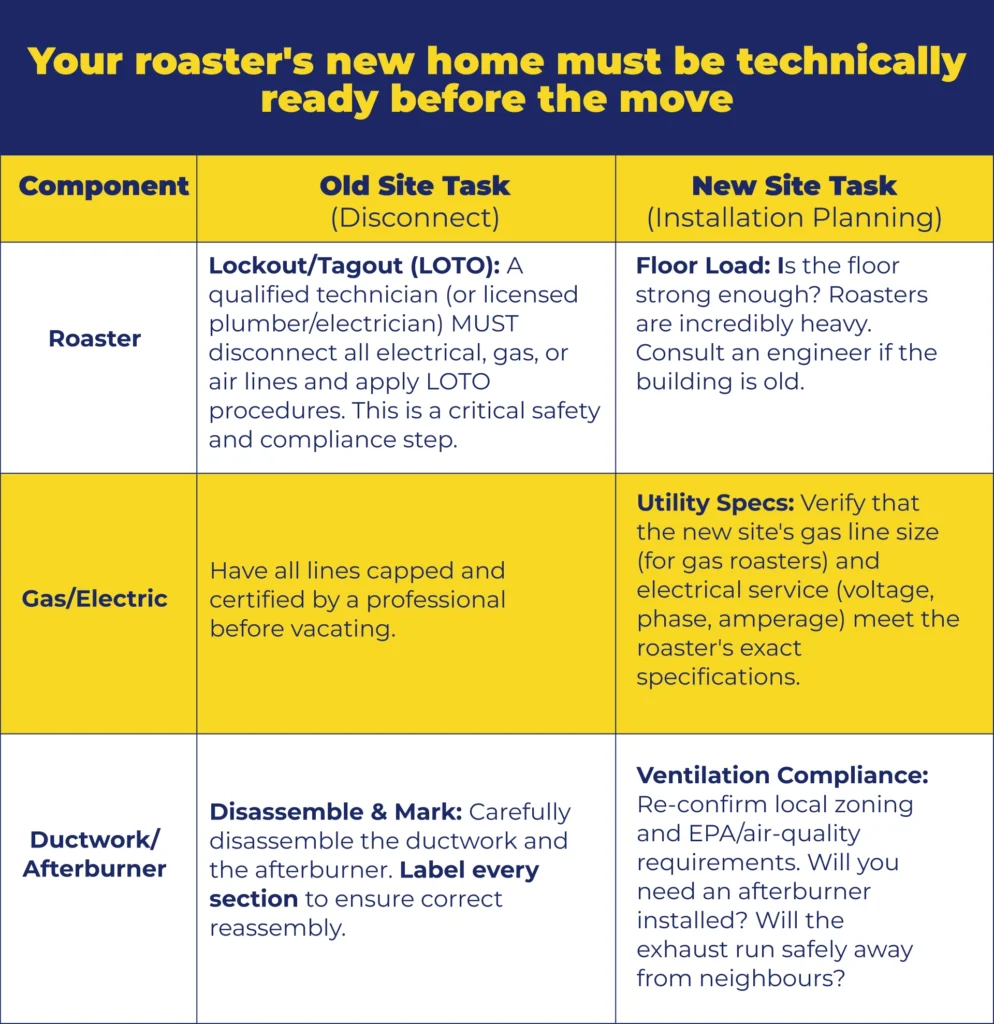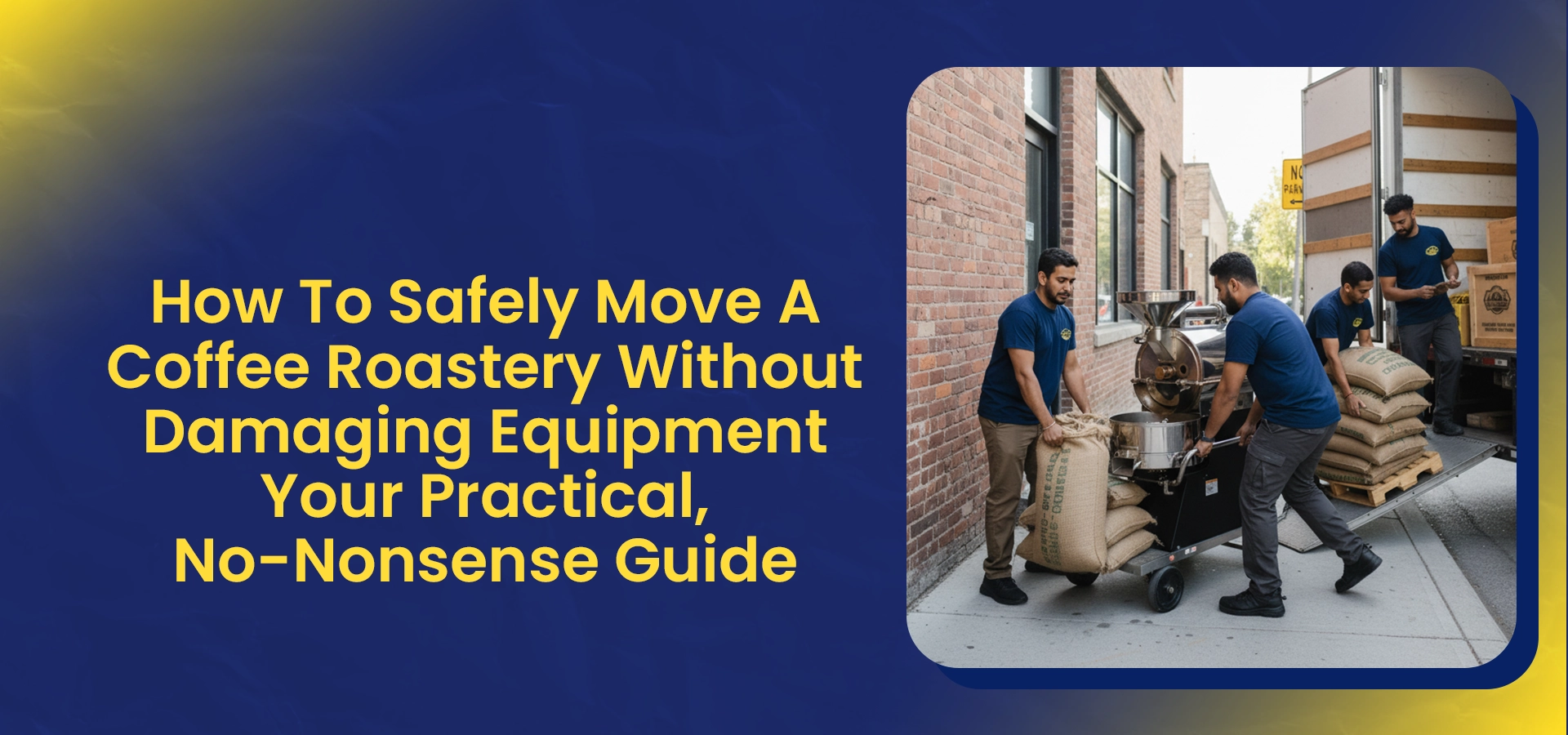Moving coffee roastery is more than just packing boxes, it’s like relocating a precision industrial kitchen. Your roaster is a heavy, delicate, and expensive piece of equipment. If it’s not handled correctly, it can become a major safety risk, damage key components, and even affect your roast profiles. That means costly repairs and downtime you don’t want.
Fortunately, you don’t have to do it alone.
Economical Movers is a professional rigging company in Ottawa that specializes in the relocation of complex commercial equipment. Therefore, in this guide, we’re sharing our expert tips to ensure your roaster, afterburner, bean silos, and other commercial coffee equipment are transported safely.
Guide For Moving Coffee Roastery Without Disrupting Sales
Don’t let your valuable roaster become a costly loss. Learn the expert steps to transport coffee roastery equipment without hurting your back or your budget.

Phase 1: Planning & Compliance (The Non-Negotiable Steps)
Before a single wrench is turned, you need a bulletproof plan that considers the sheer weight and technical requirements to move roastery coffee machine.
1. Hire A Professional Rigging Company (Seriously)
- The Absolute Rule: Do not attempt to move your main commercial roaster (anything over 120 kg/250 lbs) with an in-house team or a standard moving crew. Coffee roasters are heavy and should never be moved manually. The cost of hiring a specialized rigging company is drastically less than the cost of personal injury or catastrophic damage to a multi-thousand-dollar machine.
- What To Look For:
- Experience: Ask for references of past coffee roastery or heavy machinery moves (milling equipment experience is also a good sign).
- Equipment: They must be equipped with specialized tools like toe jacks, hydraulic dollies, forklifts, and proper strapping, not just furniture blankets and shoulder straps.
- Insurance: Ensure they have robust liability insurance that specifically covers moving heavy, complex machinery.
2. Get Your New Site Certified (Zoning and Utilities)
Your roaster’s new home must be technically ready before the move.

Phase 2: Roaster Preparation Checklist
You need to prepare the equipment to minimize stress and prevent small, loose parts from causing major issues during transit.
Deep Clean The Machine
Chaff, dust, and oil are a fire hazard and can clog during transport.
- Chaff Collector: Completely empty, clean, and dry the chaff collector and related ducting.
- Cooling Tray: Clean out all residue.
- Drum/Interior: Perform a thorough cleaning (some companies use dry ice cleaning) to remove built-up creosote and oils. A clean machine is a safer machine to move.
- Remove All Loose Parts: Take off removable trays, lids, drop shoots, and any non-essential components. Box and label these separately.
Secure All Moving/Sensitive Parts
The vibrations of the road are your enemy.
| Part | Action | Why? |
|---|---|---|
| Roaster Drum | Secure the drum mechanism to prevent movement. Consult your roaster’s manual for recommended transit restraints or bracing. | Prevents damage to bearings, drive motors, and drum alignment from road vibration. |
| Sensors & Thermocouples | Remove or heavily pad delicate temperature probes (BT/ET thermocouples) and control panels. | These are precision instruments. A small bump can cause a major calibration issue. |
| Motors & Belts | Check all motor mounts. If necessary, place temporary bracing to ensure heavy motors don’t shift. | Minimizes stress on drive belts and prevents motor mounts from cracking. |
Palletizing The Roaster (The Key To Rigging)
Your roaster needs to be firmly attached to a solid, transportable base.
- Lift: Use toe jacks or pry bars to lift the machine a few inches off the ground, one side at a time.
- Block: Insert solid wooden blocks for temporary support.
- Pallet/Skid: The rigging crew will use a large, custom-built pallet or heavy-duty skid that is wider than the roaster’s footprint, often incorporating anti-slip features like rubber matting or a high-friction surface to secure the machine and prevent shifting.”
- Secure: The roaster must be strapped and bolted to the skid, ensuring a low center of gravity. Use heavy-duty, rated strapping materials.
Phase 3: The Transport
This is where the professionals earn their fee. Your job is to supervise and communicate.
- The Proper Load-Out: For smaller roasters (anything over 12 kg/26 lbs), a truck with a lift gate might suffice, provided you have a forklift or stacker to manage the weight. For larger roasters, you will likely require a specialized drop deck trailer or a flatbed to reduce the height the machine has to be lifted, making the process significantly safer.
- Winching and Rolling: Riggers use specialized tools like manual pallet jacks (for machines up to 5,500 lbs), industrial-grade pneumatic-tired dollies, or even steel gas pipes (for rolling across smooth, solid floors in tight spaces) to move the machine carefully out of the building and onto the truck. Slow and steady is the only speed.
- Road Security: Once on the truck, the roaster must be secured with multiple heavy-duty straps in a criss-cross pattern to prevent any fore/aft or lateral shifting. The driver should be aware that they are transporting extremely fragile, heavy equipment.
Phase 4: Re-Installation & Calibration
The move isn’t over until you’re roasting back to your standard profile.
- Placement: Use your detailed floor plan for the new facility. The coffee roastery movers will move the roaster directly to its final spot.
- Un-Rigging: Once in place, the machine is un-strapped, un-bolted, and the pallet/skid is carefully removed.
- Re-connect Utilities: Only certified, licensed professionals should reconnect the gas/electric and exhaust systems. The gas connection is particularly crucial for safety and optimal burner performance.
- Reassemble: Reinstall your ductwork (using your labels!), cooling tray, and any other components you removed.
- Professional Service Call: Schedule a maintenance visit with a qualified coffee roaster technician (ideally, the machine’s manufacturer/dealer) to:
- Check Drum Alignment: Ensure the drum is still running true.
- Calibrate Sensors: Re-calibrate all temperature probes and control panels.
- Test Burner: Optimize the combustion air-to-fuel gas ratio and check for proper ignition and stable flame.
- Season the Machine: Run a few “sacrificial” roasts to burn off any new creosote or dust introduced during the move and stabilize the drum’s thermal properties.
Besides The Roaster, What Other Equipment Needs Special Attention When Moving A Coffee Roastery?
The biggest focus, after the roaster itself, must be on three critical systems:
1. Exhaust System (Ducts, Cyclone, Afterburner):
Why they matter: This equipment controls smoke, smells, and fire risk.
Moving Tip: You must professionally deep-clean these parts before the move. They are full of flammable coffee oils and chaff. Disassemble the ducts carefully and label everything so they fit perfectly when reassembled.
2. Bean Handling Gear (Destoner, Scales, Loaders):
Why they matter: They contain sensitive, calibrated parts that ensure the quality and correct weight of your coffee.
Moving Tip: Handle them like fragile instruments. They need secure padding and gentle transport to keep their precision and ensure they weigh your batches accurately in the new location.
3. Green Coffee Inventory:
Why it matters: This is your product. Green beans must be protected from changes in temperature, humidity, and pests.
Moving Tip: Plan your roasting to use up as much stock as possible. Secure any remaining green coffee tightly on pallets to prevent spoilage during transit.
What Permits Are Needed To Relocate A Coffee Roastery In Ottawa?
Relocating in Ottawa means getting the official nod from the city and province for three main things:

1. Zoning & Building Permits (City of Ottawa):
What you need: You need permission to use the new building for industrial/manufacturing work (coffee roasting). If you are building new walls or connecting major utilities, you need a Building Permit.
Action: This takes the longest! Start immediately by submitting site plans.
2. Air Quality/Emissions Permits (Provincial):
What you need: The province (specifically the Ministry of the Environment) must approve your roaster’s exhaust and its environmental impact (smoke and odour). This is often called an Environmental Compliance Approval (ECA).
Action: Treat the relocation like a new setup. Apply for this permit early, as it is mandatory and takes months to process.
3. Safety Inspections (TSSA & Fire Services):
What you need: Since you use gas and high heat, you need safety approvals for the connections. This includes approvals from the TSSA (for gas lines) and a final inspection from the local Fire Services.
Action: Hire only licensed tradespeople to handle the connections so you can pass the final safety tests.
Final Takeaway
Frequently Asked Questions For Moving Coffee Roastery
1. What Is The Cost To Move The Coffee Roastery?
Moving a coffee roastery in Ottawa typically costs between $1,000 and $4,000, depending on the size of your equipment and extra services like packing or climate-controlled transport. Getting a quote from experienced commercial movers is the best way to know the exact price.
2. What Temporary Roasting Options Are There In The Ottawa Area?
Many roasters offer short-term contract roasting or shared commercial kitchens where you can continue production while relocating. Some local specialty coffee companies may also allow you to rent their roasters for small batches. This keeps your business running smoothly and maintains product consistency during the move.
3. What Other Ways Can A Roastery Minimize Disruption During Relocation?
Planning the move in phases, like moving non-essential equipment first, can reduce downtime. Backing up inventory, labeling everything clearly, and coordinating with staff ensures operations stay organized. You can also schedule the move during slower production periods to minimize impact on sales.
4. Are There Any Cost Effective Ways To Build Coffee Roastery Inventory?
Buying green beans in bulk or negotiating short-term supplier deals can lower costs while ensuring you have enough stock. Utilizing storage solutions like climate-controlled warehouses preserves quality without overloading your roastery. Rotating inventory strategically avoids spoilage and keeps capital tied up efficiently.
5. What Are The Best Practices For Cleaning A Roaster Before A Move?
Completely cool the machine, remove chaff and beans, and vacuum out all residue to prevent contamination during transit. Disassemble removable parts carefully and wrap them individually to avoid scratches or dents. A clean roaster reduces the risk of mechanical issues and ensures a smooth restart at the new location.
6. What To Consider Flatbed Versus A Drop Deck Trailer For Transporting A Coffee Roaster?
Flatbeds are easier for oversized equipment and offer quick loading, but they expose machinery to weather. Drop deck trailers lower the load closer to the ground, which improves stability for heavy, delicate roasters. Your choice should balance equipment size, weight, and the need for protection during transport.
7. How Does Climate Control During Transport Preserve Green Coffee Bean Quality?
Green coffee beans are sensitive to humidity and temperature swings, which can affect flavor and shelf life. Climate-controlled transport maintains consistent conditions, preventing moisture absorption or degradation. This is especially important for premium beans where even small changes can impact roast quality.
8. Are There Any Specific Fire Code Requirements For Coffee Roasteries In Ottawa?
Yes, roasteries are subject to fire codes related to ventilation, exhaust systems, and flammable material storage. Inspectors often require proper clearance around roasters, fire suppression systems, and smoke alarms. Complying early avoids fines and keeps staff, equipment, and your lease safe.



